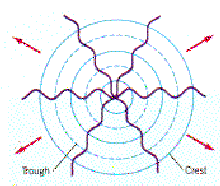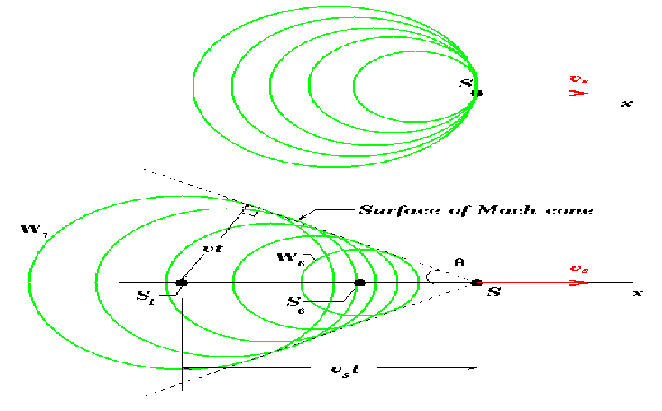A sources of waves which is stationary will emit waves uniformly in all directions.
 A
A
The waves move at a speed defined by the equation![]() If the source itself is moving at a speed close to
If the source itself is moving at a speed close to![]() then it nearly keeps pace with its own spherical wave fronts as shown in the top diagram below.
then it nearly keeps pace with its own spherical wave fronts as shown in the top diagram below.

In the second diagram the speed of the source is larger than the speed of the wave. When the source S was at position![]() it generated wavefront
it generated wavefront![]() and when it was at position
and when it was at position![]() it generated wavefront
it generated wavefront![]() All the spherical wavefronts expand at the speed
All the spherical wavefronts expand at the speed![]() and their boundaries move along the surface of a cone. In the case of a wave source in a fluid like water or air, the cone signifies a shock wave and is referred to as the Mach cone. The surface of this cone has half-angle
and their boundaries move along the surface of a cone. In the case of a wave source in a fluid like water or air, the cone signifies a shock wave and is referred to as the Mach cone. The surface of this cone has half-angle![]() and is tangent to all the wave fronts. A similar effect occurs for light when an electrically charged particle traverses a dielectric medium at speeds that are greater than those of light in that medium. In this case, the electric and magnetic fields associated with a rapidly moving charge excite the atoms of the medium. The excited atoms emit part of their light in the form of a coherent wavefront of radiation at fixed angle with respect to the trajectory of the charged particle as shown below.
and is tangent to all the wave fronts. A similar effect occurs for light when an electrically charged particle traverses a dielectric medium at speeds that are greater than those of light in that medium. In this case, the electric and magnetic fields associated with a rapidly moving charge excite the atoms of the medium. The excited atoms emit part of their light in the form of a coherent wavefront of radiation at fixed angle with respect to the trajectory of the charged particle as shown below.

To be precise, this radiation, named Cerenkov radiation after its discoverer, is produced whenever the velocity \beta c of the particle exceeds![]() where
where![]() is the speed of light in a vacuum,
is the speed of light in a vacuum,![]() is the refractive index of the medium traversed by the charge, and
is the refractive index of the medium traversed by the charge, and![]() is the usual relativistic factor
is the usual relativistic factor
![]() if
if![]() is the velocity of the particle. For most cases, energies are high enough for us to assume
is the velocity of the particle. For most cases, energies are high enough for us to assume![]() From the diagram above, we can see that the light cone formed in Cerenkov radiation has a value
From the diagram above, we can see that the light cone formed in Cerenkov radiation has a value![]() The radiation appears as a continuous spectrum. In a dispersive medium, both
The radiation appears as a continuous spectrum. In a dispersive medium, both![]() and
and![]() are functions of the frequency of radiation. The number of photons at a particular frequency or wavelength, as it turns out, is proportional to
are functions of the frequency of radiation. The number of photons at a particular frequency or wavelength, as it turns out, is proportional to![]() This means that, in the visible range, blue light predominates over all other colours. The blue glow that emanates from the water in which highly radioactive nuclear reactor fuel rods are stored is caused by the Cerenkov effect. For fuel rods, much of the radiation they emit is in the form of high energy electrons. The electrons travel through the water at a velocity greater than that of light in water and hence cause the characteristic ``Cerenkov glow''.
This means that, in the visible range, blue light predominates over all other colours. The blue glow that emanates from the water in which highly radioactive nuclear reactor fuel rods are stored is caused by the Cerenkov effect. For fuel rods, much of the radiation they emit is in the form of high energy electrons. The electrons travel through the water at a velocity greater than that of light in water and hence cause the characteristic ``Cerenkov glow''.
